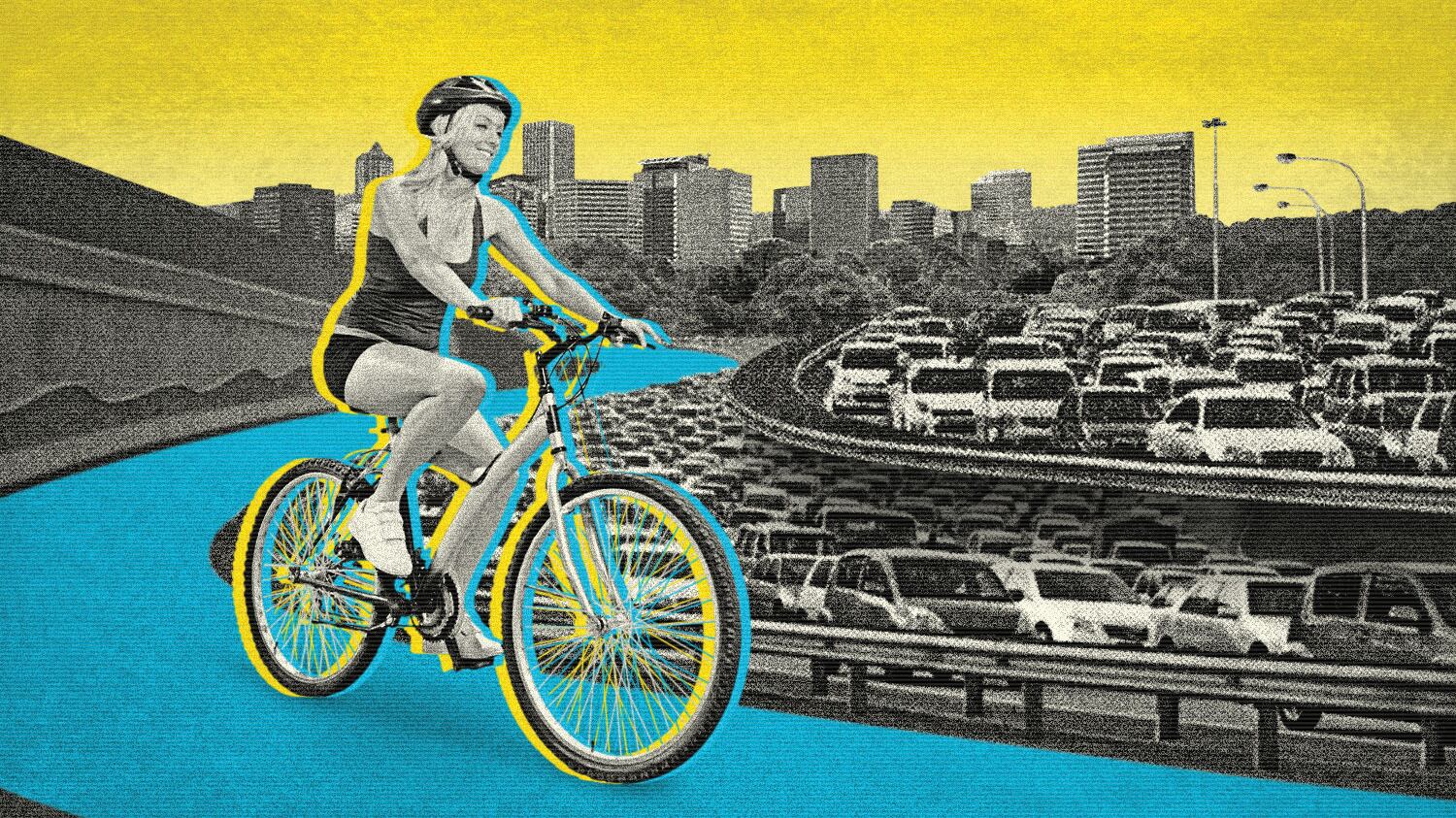Maybe it was the closed Morrison Bridge that did me in—three lanes of cars squeezing like sausages onto a clogged I-5 on-ramp. Maybe it was the year I spent circling blocks near WW's Slabtown office with the blank stare of the depressed, hoping someday to park.
I'm done driving to work in this town.
Maybe you should be, too.
Ever since scotching the Mount Hood Freeway, Portland has spent a solid 40 years making this a city built around pedestrians, trains and bicycles. Whatever your opinion of Portland's broad strategy of city planning, we're locked in at this point.
Stop fighting. Give up. Roll with it.
Driving in Portland is now awful, and it's going to get worse.
Portland's rush hour is terrible.
Portland rush-hour traffic is now a lot like happy hour at a failing dive bar: It takes up more than five numbing hours of every day.
There are too many people, not enough roads, and natural bottlenecks from hills and bridges. Add in the nearly 200,000 people who moved here since 2010, and it starts to get ugly. In the 10 years between 2004 and 2014, our rush-hour delay went from 25th-worst in the nation to 12th, according to the Texas A&M Transportation Institute.
It's this way because we made ourselves this way. Portland's founding myth, our epic, our love song to ourselves is that in the early 1970s we turned down 100 miles of freeways.
"Cesar Chavez Boulevard would have been a freeway, a cloverleaf interchange. There would have been a freeway up Fremont, freeways everywhere. In the grid cell created by freeways, you would have had suburban cul-de-sacs," says Portland State University professor and city planner Ethan Seltzer. "It was about creating a city for cars. Folks who were in Portland said, 'Wait a minute, we don't want that to happen.'"
It didn't.
Instead, we built a human-scale, Jane Jacobs-style, transit-centric, bike-friendly city. That's probably why we have the most bike commuters in the country, at about 7 percent.
Roads are narrowing, and speed limits are going down.
Even as Portland traffic gets worse, streets from East Burnside to Southeast Division and Foster Road are going on a "road diet," shedding car lanes to make the streets safer for pedestrians and bicyclists—mostly by creating slow, steady, one-lane traffic. It actually works pretty well so far, but God help you if you're making a left turn on Burnside.
Portland has a safety plan called Vision Zero, and the idea is simple: If cars keep hitting people, the city fucks with the cars. (The Portland Bureau of Transportation's Dylan Rivera insists it's a bit more multifaceted than that.)
"In two years, we've seen a crash reduction of over 40 percent," says Margi Bradway, head of Active Transportation at the PBOT, about the road diet on Division Street. "We reorganized from three to two lanes. We've seen a huge return."
Speed limits overall, meanwhile, are probably going down. This month, the Oregon House moved a bill to the Senate that would allow PBOT to lower residential speed limits to 20 mph. Southeast Hawthorne Boulevard had already been lowered to 20 mph after a fatal crash, as was the speed limit on nearly 80 miles of greenways—roads designated for bicycles, sometimes outfitted with flowerpots in the middle to stop cars from driving on them.
This makes it easier to ride your bike faster than the cars.
Parking is awful.
"Parking policy is one of the better levers that is available to help people make the right choice for themselves," says activist Tony Jordan of Portlanders for Parking Reform. "Parking costs something, and building it has effects on how the traffic system works, and induces people to drive or not drive."
(Jordan drives Car2Go but does not own a car.)
That's part of the reason our city calls for limits on parking.
"Typical suburban parking is four spaces per 1,000 square feet of office," says retired Portland city planner Andy Cotugno. "We required people to lower their standards and define maximums—three per 1,000 does quite nicely in suburban areas, two per 1,000 in cities, one per 1,000 in downtown."
Former Mayor Charlie Hales was for, against, and then for allowing apartments to be built without parking, which squeezes street space. Near Division, 224 apartments in 13 blocks were designed without parking, causing freak-outs. In already-crowded Slabtown, a 123-unit pair of apartment buildings called the Tess O'Brien was not required to have parking. Meanwhile, parking meters have been plunked down in Nob Hill and Slabtown and on the central eastside—while people in Northwest got so fed up with how hard it was to park they voted this month to raise their own annual parking permit fees to $180, hoping fewer people would store their cars there.
"In Northwest Portland, finding car parking is such a headache," say Bradway. "We took a vote of residents in Northwest Portland, and they wanted to raise the fee on themselves and their neighbors."
There are, however, plenty of bike racks.
It's probably not going to get any better.
Our city will receive an influx of 260,000 people by 2035, according to PBOT estimates—about 140,000 new commuters to 140,000 new jobs.
"If everyone who moves to Portland in the next 20 years drives to work alone, that will have effects: reduced economy, reduced quality of life," says Rivera.
If you're looking for relief in the form of new roads, you have a long wait. The next fully funded road project on the horizon in the central city is a bike bridge on Northwest Flanders Street. The last bridge Portland built, Tilikum Crossing, doesn't allow cars.
Portland builds mostly when it gets federal and state grants—money likely to go to twee, bikey, eco-happy stuff.
"Not only can we not afford to build new highways, but it would diminish our quality-of-life aspirations to widen roads," says Rivera. "Widening roads often involves wiping out neighborhoods next to those roads. Our vision for growing is making the most of the current road system we have, adding facilities that enable people to safely bike, walk and take public transit. The roads we have are the roads we are going to have."
We're not making a city policy argument here. We're being very blunt about maybe the only thing that will make this city run better—around three times as many people need to bike for our planning to make sense.
And yes, there are tons of people pushed far to the outskirts of the city by housing costs, meaning biking is not feasible for everyone. But if you're an able-bodied person fortunate enough to live and work within the inner 50 blocks of the city, who has benefited from the 40 years of public planning required to make the bikeable, walkable, neighborhood-focused city you wanted so badly to live in?
Get on your bike and get out of the way of all the poor schmucks who actually need to drive. Besides, you'll save tons of money on CrossFit.

Welcome to the 2017 Bike Issue
Portland Made Driving Miserable. All You Can Do Now is Bike.
What It Would Take For Portland To Become a Globally Elite Bike City?
A Selection of the Best New Cycling Gear
BikeTown isn't Just For Tourists. I Used It For a Week and It Was Great.
BikeTown Is Killing Portland Bike Shops
I Took An Epic E-Bike Ride from the Willamette Valley to the Coast
Is Portland's Proud Bike Culture Stunting the Adoption of E-Bikes?

